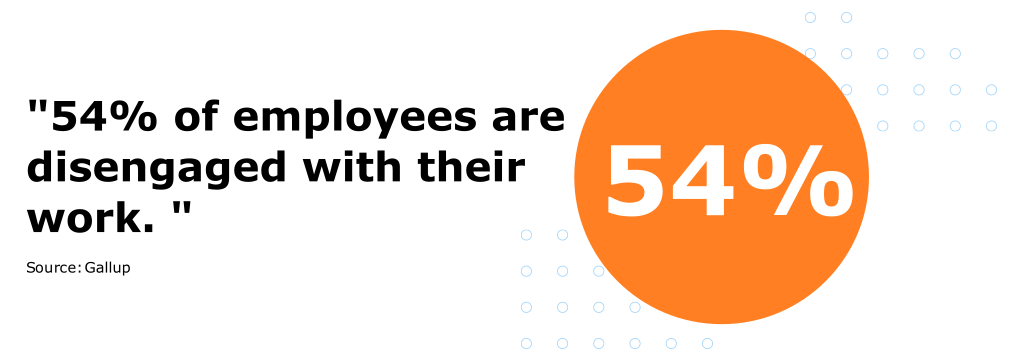
According to a 2020 Gallup poll, 54% of employees are disengaged with their work. That means over half of employees are only putting minimum effort into their work–and may even be seeking a job elsewhere.
This can have disastrous consequences for your business. From sales to customer service, each team member plays a vital role in the health of your business. If an employee is disengaged, their attitude can affect the way they interact with customers, their alertness when safety precautions are necessary, and negatively impact their coworkers.
Fortunately, even if you don’t have a dedicated human resources department, there are HR outsourcing services available to evaluate and act on your current employee engagement.
This article will dive into the types of employee engagement with examples of initiatives that you can take to increase engagement.

What is Employee Engagement?
Employee engagement refers to how passionate your employees are about the work they do. It determines how much of their energy, attention, and ideas they are willing to dedicate to the task at hand.
Importance of Employee Engagement
Employee engagement, like so many other metrics in business, often goes unnoticed when engagement is high, and it only receives attention when poor engagement has a negative impact. By proactively increasing employee engagement, you can increase the efficiency of your business.
When compared to businesses with the lowest employee engagement, those with the highest engagement saw:
- 23% increase in profits
- 18% decrease in employee turnover
- 64% decrease in safety accidents
- 18% increase in sales
Businesses with high employee engagement are safer, retain more employees, close more sales, and are more profitable.
Types of Employee Engagement
In order to start actively increasing employee engagement, you need to first take stock of how you are currently performing. Maslow’s hierarchy of needs is a great template for seeing what areas of your business bolster or deter employee engagement.
Hierarchy of Needs
People need to satisfy basic needs—like food and water—before pursuing higher-level needs like creative expression. Similarly in business, employees need basic levels of security and engagement in order to start producing at a high level for you. How is your business currently performing in the following areas?
- Physiological: Are your employees allowed enough break time to eat and use the restroom?
- Safety: Is your machinery regularly maintained? How do you respond to inclement weather? Do you have policies in place to respond to harassment?
- Belonging: Do your employees feel like they are part of a team with other people, or do they only feel that they are a part of a bigger machine?
- Esteem: Do you acknowledge employees for great performance? Do you offer support for underperforming employees so they can improve their performance and be proud of it?
- Self-Actualization: Do you reward creativity? Do your employees feel that their ideas can make a difference in your business?
If your employees don’t feel safe at work, they will have trouble performing at their highest capabilities. Still, that doesn’t mean that you can stop there. Belonging, esteem, and self-actualization all play vital roles in employee retention and engagement.
Manager vs. Employee Driven
When it comes to employee engagement, managers and employees can have different goals. Managers will typically focus on what will benefit the business the most, like increasing productivity and employee retention.
Employees tend to focus more on what benefits them and gives them a better relationship with their work. They thrive when given opportunities for career development and have clearly defined roles with pay that scales with responsibilities.
What Are the Best Employee Engagement Activities?
Once you know what will motivate your employees to be more engaged with their work, how do you actually make an impact?
Here are some examples of initiatives that you can take to increase employee engagement:
- Create Benchmarks: Set public goals that are measurable, attainable, and timely. When your employees have clear objectives to achieve, they are more likely to actively work towards them (Think about a to-do list; it can be energizing to check things off).
- Check-in: Set regular one-on-one meetings or make time for surveys where your employees can tell you how they feel about their performance and what they need to be more successful. This is a great opportunity to discover hidden blockers, like if an employee has trouble using essential software or their equipment is breaking down.
- Celebrate Success: Weekly, company-wide calls are an excellent time for your different teams to get together and share success stories, as well as shout-out employees that had an exemplary performance. This is a great way for everyone to feel connected and see that what they do on a daily basis matters.
- Support Growth: Offer opportunities for employees to learn new skills. A great place to start is with technology. By hosting workshops, your employees can learn to overcome headaches and they’ll be more productive.
At Milestone, our outsourced HR services can help you implement these changes. Employees that feel an investment in effort from management will be more motivated to pour that energy back into their work. They feel better about what they do, and they perform better. Win-win.
Employee Engagement Activities During Work from Home
With the 2020 shift to work-from-home and hybrid models came new challenges to developing employee engagement. How can employees feel connected to their work when they’re isolated from their teams?
Fortunately, there are still ways to drive passion remotely. In fact, remote and hybrid work models can even improve engagement because certain needs (like comfort and work-life balance) are often better met outside of an office setting.
With the right toolset, you can strengthen employee engagement no matter where your team is working from. One of the most straightforward ways to keep your employees engaged is to respect their time. When were they able to leave the office? Do you find that employees are working longer hours at home because boundaries are blurred? Set clear expectations and do-not-disturb hours when possible so your team can recharge for the next day.
Like in an office, your employees will face challenges on a regular basis. Keep checking in to see what they need to succeed, especially if they are in a transitional phase and getting used to a new workspace.
Do You Struggle with How to Manage Employee Engagement?
The benefits of increasing employee engagement–from decreased turnover to increased profits–are clear. But how do you get there? If you have a robust HR department, then you can begin implementing these strategies after assessing your current engagement.
If you would like to get started but don’t have the internal resources for a long-term employee engagement plan, then an outsourced HR services provider might be right for you. At Milestone, we discover what your employees value most, then implement data-back solutions to build energy behind your vision. Contact us to learn more about our employee engagement services. We’d love to find out how we can help you!
Related Content

Remote Workforce Management
The importance of remote workforce management cannot be overstated as it involves ensuring that remote employees remain productive and engaged.

Can A 501c3 Have Employees?
501c3 organizations must adhere to specific guidelines and practices to maintain compliance with IRS regulations.

How Does A Nonprofit Hire Employees?
Hiring employees in a nonprofit organization involves a carefully structured nonprofit hiring process to ensure legal compliance and organizational effectiveness.
Stay in the know